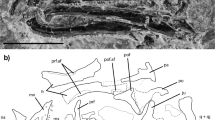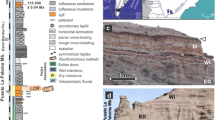Abstract
Sphenodontian reptiles successfully radiated during Triassic and Jurassic times, but were driven almost to extinction during the Cretaceous period1. The sparse Early Cretaceous record of sphenodontians has been interpreted as reflecting the decline of the group in favour of lizards, their suspected ecological successors2. However, recent discoveries in Late Cretaceous beds in Patagonia partially modify this interpretation. Numerous skeletons of a new sphenodontian, Priosphenodon avelasi gen. et sp. nov., were collected from a single locality in the Cenomanian–Turonian Candeleros Formation, where it is more abundant than any other tetrapod group recorded in the quarry (for example, Crocodyliformes, Serpentes, Dinosauria and Mammalia)3,4. Adult specimens of Priosphenodon reached one metre in length, larger than any previously known terrestrial sphenodontian. Here we propose, using available evidence, that sphenodontians were not a minor component of the Cretaceous terrestrial ecosystems of South America, and that their ecological replacement by squamates was delayed until the early Tertiary. The new discovery helps to bridge the considerable gap in the fossil record (around 120 million years) that separates the Early Cretaceous sphenodontians5,6,7 from their living relatives (Sphenodon).
This is a preview of subscription content, access via your institution
Access options
Subscribe to this journal
Receive 51 print issues and online access
$199.00 per year
only $3.90 per issue
Buy this article
- Purchase on Springer Link
- Instant access to full article PDF
Prices may be subject to local taxes which are calculated during checkout


Similar content being viewed by others
References
Reynoso, V. H. A “beaded” sphenodontian (Diapsida: Lepidosauria) from the Early Cretaceous of Central Mexico. J. Vert. Paleontol. 17, 52–59 (1997)
Carroll, R. L. Vertebrate Paleontology and Evolution (Freeman, New York, 1988)
Novas, F. E. et al. Primer registro de lepidosaurios esfenodontes para el Cretácico Superior. Ameghiniana 36, 16R (1999)
Apesteguía, S. et al. Los tetrápodos de ‘La Buitrera’, Formación Candeleros (Cenomaniano temprano), Río Negro. I Congr. ‘O. A. Reig’ Vertebr. Básica Evol. Hist. Filos. Ciencia (in the press)
Evans, S. E. & Sigogneau-Russell, D. New sphenodontians (Diapsida: Lepidosauria: Rhynchocephalia) from the Early Cretaceous of North Africa. J. Vert. Paleontol. 17, 45–51 (1997)
Rich, T. H. V., Molnar, R. E. & Rich, P. V. Fossil vertebrates from the Late Jurassic or Early Cretaceous Kirkwood Formation, Algoa Basin, Southern Africa. Trans. Geol. Soc. S. Afr. 86, 281–291 (1983)
Barbera, C. & Macuglia, L. Revisione dei tetrapodi del Cretácico Inferiore di Pietraroja (Matese Orientale, Benevento) appartenenti alla collezione Costa del Museo di Paleontologia dell'Università di Napoli. Mem. Soc. Geol. Ital. 41, 567–574 (1988)
Hugo, C. & Leanza, H. Hoja Geológica Roca (3969-IV). Inst. Geol. Rec. Nat. SEGEMAR, 309, 1–95 (1999)
Haeckel, E. Generelle Morphologie der Organismen. Zweiter Band: Allgemeine Entwicklungsgeschichte der Organismen (Reimer, Berlin, 1866)
Williston, S. W. The Osteology of the Reptiles (Harvard Univ. Press, Cambridge, 1925)
Rasmussen, T. E. & Callison, G. A new herbivorous sphenodontid (Rhynchocephalia: Reptilia) from the Jurassic of Colorado. J. Paleontol. 55, 1109–1116 (1981)
Pol, D., Apesteguía, S., Novas, F. E. & Carignano, A. P. Evolución y paleobiogeografía de los cocodrilos del Cretácico tardío de Gondwana. Congr. Arg. Paleontol. Bioestrat. (in the press)
Gallina, P. A., Apesteguía, S. & Novas, F. E. ¿Un elefante bajo la alfombra? Los Rebbachisauridae (Sauropoda, Diplodocimorpha) del Cretácico de Gondwana. Nuevas evidencias en “La Buitrera” (Fm. Candeleros), provincia de Río Negro. Ameghiniana 39, 10R (2002)
Apesteguía, S., Rougier, G. W., Novas, F. E. & Novacek, M. A cladotherian mammal from the Early Late Cretaceous of Patagonia. Congr. Argent. Paleontol. Bioestrat. (in the press)
Apesteguía, S. & Agnolin, F. L. Los dipnoos del Cretácico de Patagonia. Ameghiniana 39, 5R (2002)
Fraser, N. C. & Benton, M. J. The Triassic reptiles Brachyrhinodon and Polysphenodon and the relationships of the sphenodontids. Zool. J. Linn. Soc. 96, 413–445 (1989)
Wu, X.-C. The Comparative Anatomy and Systematics of Mesozoic Sphenodontidans. Thesis, McGill Univ. (1991)
Throckmorton, G. S. & Hopson, J. A. A redescription of Toxolophosaurus cloudi Olson, a lower Cretaceous herbivorous sphenodontid reptile. J. Paleontol. 55, 586–597 (1981)
Fraser, N. The osteology and relationships of Clevosaurus (Reptilia, Sphenodontida). Phil. Trans. R. Soc. Lond. B 321, 125–178 (1988)
Reynoso, V. H. An unusual aquatic sphenodontian (Reptilia: Diapsida) from the Tlayua Formation (Albian) of Central México. J. Paleontol. 74, 133–148 (2000)
Báez, A. M. & Gasparini, Z. Orígenes y Evolución de los anfibios y reptiles del Cenozoico de América del Sur. Acta Geol. Lilloana 14, 149–232 (1977)
Evans, S. E., Prasad, G. V. R. & Manhas, B. K. Fossil lizards from the Jurassic Kota Fm. of India. J. Vert. Paleontol. 22, 299–312 (2002)
Zils, W., Werner, C., Moritz, A. & Saanane, C. Tendaguru, the most famous dinosaur locality of Africa. Review, survey and future prospects. Documenta Naturae 97, 1–41 (1995)
Broschinsky, A. & Sigogneau Russell, D. Remarkable lizard remains from the Lower Cretaceous of Anoual (Morocco). Ann. Paléontol. 82, 147–175 (1996)
Albino, A. El lagarto más antiguo de la Argentina. I Congr. ‘O. A. Reig’ Vertebr. Básica Evol. Hist. Filos. Ciencia (in the press)
Evans, S. E. & Yabumoto, Y. A lizard from Early Cretaceous Crato Formation, Araripe Basin, Brazil. N. Jahr. Paläontol. Geol. 6, 349–364 (1998)
Estes, R. & Báez, A. in The Great American Biotic Interchange (eds Stehli, F. & Webb, S.) 139–197 (1985)
Smith, K. T. Iguanian phylogeny: implications for the origin of a portion of the recent Malagasy biota. J. Vert. Paleontol. 21 (suppl. 3), 102A (2001)
Evans, S. E., Prasad, G. V. R. & Manhas, B. K. Rhynchocephalians (Diapsida: Lepidosauria) from the Jurassic Kota Formation of India. Zool. J. Linn. Soc. 133, 309–334 (2001)
Acknowledgements
We thank the Avelás, Salinas and Pincheira families, C. Muñoz, L. Fernández and the ENDEMAS for their valuable help in the field. S. Reuil, A. Scanferla, M. Isasi and E. Villalba are also acknowledged for preparation of specimens; J. González and G. Lío for illustrations; and H. Canuti for photographs. Field work and study were supported by The National Geographic Society, the Agencia Nacional de Promoción Científica y Tecnológica, Akapol SA, and the Renault Argentina (to F.E.N.), and by The Jurassic Foundation and The Rotary Club (to S.A.). S. Evans, R. Molnar, G. Rougier and D. Pol substantially improved this work with useful comments and critical review.
Author information
Authors and Affiliations
Corresponding author
Ethics declarations
Competing interests
The authors declare that they have no competing financial interests.
Supplementary information
Supplementary Notes
This file includes details of the cladistic analysis and character list for the study. (DOC 46 kb)
Erratum
This file contains details of an error in the posting of the Supplementary Information online. (DOC 19 kb)
Rights and permissions
About this article
Cite this article
Apesteguía, S., Novas, F. Large Cretaceous sphenodontian from Patagonia provides insight into lepidosaur evolution in Gondwana. Nature 425, 609–612 (2003). https://doi.org/10.1038/nature01995
Received:
Accepted:
Issue Date:
DOI: https://doi.org/10.1038/nature01995
This article is cited by
-
Early Cretaceous lepidosaur (sphenodontian?) burrows
Scientific Reports (2023)
-
An exceptionally preserved Sphenodon-like sphenodontian reveals deep time conservation of the tuatara skeleton and ontogeny
Communications Biology (2022)
-
A new Cretaceous thyreophoran from Patagonia supports a South American lineage of armoured dinosaurs
Scientific Reports (2022)
-
Sphenodontian phylogeny and the impact of model choice in Bayesian morphological clock estimates of divergence times and evolutionary rates
BMC Biology (2020)
-
A stem acrodontan lizard in the Cretaceous of Brazil revises early lizard evolution in Gondwana
Nature Communications (2015)
Comments
By submitting a comment you agree to abide by our Terms and Community Guidelines. If you find something abusive or that does not comply with our terms or guidelines please flag it as inappropriate.



